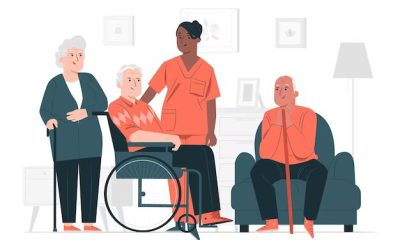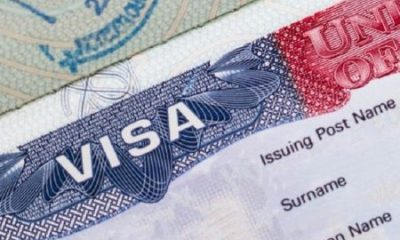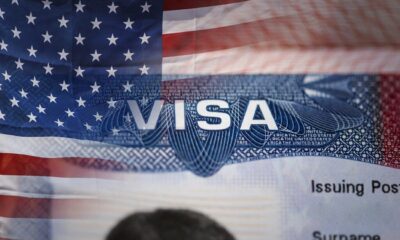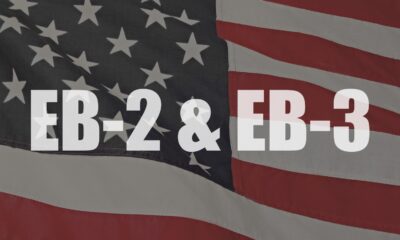Visa
Complete Guide To L1 Visa Application, Requirements, Validity & More
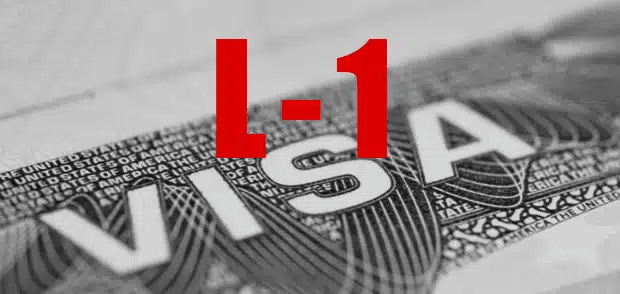
A US temporary work visa, the L1 visa, lets you transfer from a foreign company to its US branch, subsidiary, affiliate, or parent company. You must work in an executive or managing position that needs specialized expertise to receive an L1 visa. Also called Intra Company Transferee visa.
The L1 visa is not company- or country-specific. Large enterprises, medium-sized companies, and tiny start-ups can transfer staff to the US if they have a connected company.
Do I qualify for the L1 Visa?
To be eligible for the L1 Visa, the person applying has to fulfill the following criteria:
- Have employment in another country that is not the US for at least one year in the past three years.
- Have specialized knowledge, or have a managerial or executive position.
- Have a transfer offer to a managerial, executive, or specialized knowledge position in the US company.
- Be registered as a full-time employee; however, the applicant can work part-time in the US and use the rest of the time to work in their home.
- The company where the applicant works must have a subsidiary, branch, affiliate, or parent company in the US.
The Intra Company Transferee visa has no cap, therefore, it can be given to everyone who is eligible and goes through the application process. In addition, all foreign nationals are eligible for this type of visa as long as they fulfill the requirements.
What are the Types of L1 visas?
There are two types of L1 Visas:
- L1A Visa – L1 visa for Managers and Executives.
- L1B Visa – L1 visa for Specialized Knowledge staff.
Who Can Obtain the L1A Visa?
What should be the duties of a Manager to qualify for a L1 Visa?
A manager must perform the following duties to claim that title:
- Has the authority to hire and fire employees accordingly if there is no other supervisor of that function. If there is a human resource supervisor, the manager has the authority to recommend people for hiring or for firing them.
- Is in charge of the whole company or a division of it.
- Has control over the supervisors and lower level employees of the organization or the division which the manager heads.
A supervisor who oversees daily activities and reports to another supervisor is not a manager. This person is business staff since they cannot make decisions and must get consent from their boss.
Managers must have some authority over the organization and its choices to get an L1A visa for the US. Managers include marketing department heads and operations department heads.
Who is considered an Executive?
As for an executive, these duties fall under that job position:
- Is supervised only by stakeholders or a board of directors and no others
- Makes policy rules and regulations for the company
- Has the ultimate decision making power regarding the company, besides the stakeholders and the board of directors
With the exception of stakeholders and the board of directors, a person does not meet the criteria for being an executive if they must report to and be supervised directly by another person. A high level of supervision is required for an executive. The Chief Executive Officer (CEO) of a company is an example of an executive.
Who Can Obtain the L-1B Visa?
The L-1B visa is directed towards those individuals who have specialized knowledge within a company.
Key firm workers are specialized knowledge professionals. They have unparalleled understanding of the company’s products and services. Transferring this information takes time and resources. The company’s products and services would be lower without the specialist knowledge holder’s years of experience.
Many industries qualify specialist knowledge workers for L-1B visa transfers, including:
- Surgeons and physicians in hospitals.
- Engineers.
- Lawyers.
- Teachers.
- Professors.
The L-1B visa is thus given to people whose company can prove that they are indispensable to company functions.
How to Apply for the L1 Visa?
The L1 visa application process differs significantly from the H-1B visa application process. Unlike H-1B visa applicants, who must go via the US Labor Department, obtain prevailing pay certifications, and demonstrate that no eligible US workers can fill the job vacancy, L1 visa applicants do not. Learn more about the differences between L1 and H1b visas.
To apply for an L1 visa, you must first complete the following steps:
- Get a transfer offer.
- Filing Form I-129.
- Employer must pay the fees.
- File Form DS-160.
- Pay the L1 visa application fee.
- Schedule your L1 visa interview.
- Submit your L1 visa documents.
- Attend your interview.
Get a transfer offer
This is the most clear logical need. Your employer must make you an intracompany transfer offer in a managerial, executive, or specialized knowledge position if it has a branch, subsidiary, affiliate, or parent company in the United States. Then you can start working on your application.
Filing Form I-129
There are two ways to go about filing this form:
Individual Petitions
To transfer the employee to the US, the company must petition the US. The individual petition assures one employee gets the L1 visa. This includes submitting Form I-129, Petition for a Nonimmigrant Worker, and the L Supplement to USCIS. USCIS must approve the petition for the employee to apply at the US Embassy. If the petition is approved, the employer gets Form I-797.
L1 Blanket Petitions
The blanket petition has been created to enable large companies to get one approval from USCIS and transfer many employees on L1 visas to the US.
To do this, they must fulfill the following requirements:
- The organization must be in the commercial trade or service business.
- The organization must have an office in the US for one or more years.
- The organization in the foreign country and their affiliates in the US must have obtained 10 L1 approvals in the past 12 months.
- The organization in the foreign country and the affiliates in the US must have combined annual sales of at least $25 million or have at least 1,000 employees in the US.
USCIS receives Form I-129S, Nonimmigrant Petition Based on L1 Blanket Petition, from the employer. After approval, the company receives Form I-797, which all transferring employees use.
The employer might prolong the blanket petition for 3 years as needed. If the petition expires, the employer can file individual petitions but not another blanket petition for 3 years.
Besides these two differences, all L1 visa applicants, whether they have an individual or blanket petition, follow the identical steps.
File Form DS-160
Form DS-160 is necessary for most visas, including L1. The online form allows applicants to provide information about their intend to visit the US, their purpose, and other info to help the US Embassy decide. Keep the confirmation page and number after submitting the DS-160.
Pay the L1 visa application fee
The application fee for the L1 visa is $205. You must pay this fee in order for your application to be processed further. Besides this, you might be required to pay additional fees based on your home country or reciprocity measures with the US. Nevertheless, after you pay all fees, get the receipts which you will attach to your documents.
Schedule your L1 visa interview
The US Embassy you apply from must interview you for the L1 visa. Those over 13 and under 79 must schedule an interview. Do this as soon as possible because the Embassies are busy and may take a while to get to your turn. A visa interview appointment letter will be sent to you after scheduling.
Submit your L1 visa documents
You must have a file with the above-mentioned documents to submit for your application to be considered.
To apply for an L1 Visa, you must submit the following documents:
- A valid passport for an additional 6 months after your visa ends.
- A photograph meeting the US visa Photography Requirements
- The DS-160 confirmation page and code.
- The receipts that you have paid all L1 visa fees.
- The L1 visa interview appointment letter.
- For individual petitions:
Form I-129 and one copy.
Form I-797. - For blanket petitions:
Form I-129S and two copies.
Three copies of Form I-797. - Letter from employer confirming your transfer and your job description.
- Proof that you have worked with the employer for at least 1 year in the past 3 years.
- Letters from previous employers and contact information for your supervisors.
- Contact information from 2 coworkers from your current and previous job positions.
- Photographs of the inside and outside of your place of work.
- Your CV or resume.
Attend your interview
Your interview is important to your application. An officer from your applied US Embassy will interview you. The official will assess your motivations for traveling to the US and want proof of your transfer and employment in the US. If your interview goes well, your visa will be processed and your passport stamped.
What Kind of Questions Will there be on the L-1A visa Interview?
The L-1A visa interview questions will revolve around trying to see whether you meet the requirements for this visa and whether your job position falls under the managerial and executive ones. If you pass
the interview successfully, you will wait for the processing time and get the visa stamped on your passport.
What Questions Will I Answer on the L-1B Visa Interview?
The L-1B visa interviewer will ask about your job, specific knowledge, and why the company needs it. Answer questions completely to avoid incomplete information. After the interview, wait for processing and send your passport for stamping if authorized.
What is the L1 Visa Processing Time?
The L1 visa is processed quickly. Individual petitions take longer than blanket petitions, but the difference is negligible. An L1 visa usually takes 3–4 months to process.
Employers who pay for premium processing can find out if their petition is allowed or denied in 1–3 weeks.
How Long is the L1 Visa Valid?
When your employer submits Form I-129, they set the contract length. When your visa is accepted, you can work in the US for that duration. The time is also on your Form I-94 upon entering the US.
When this time is almost up, your employer can request an extension. You can stay in the US longer if the extension is authorized.
An L1 visa can only be used in the US for a limited time. This depends on your L1 visa type. L1A visas allow you to work in the US for 7 years, whereas L1B visas allow 5 years. When your maximum time is up, you can explore additional options, which may lead to permanent US residency.
Can I Extend my L1A Visa?
USCIS will extend L1A visa status for 2 years if the requirements are met. USCIS authorizes two L1A visa extensions, extending your stay in the US by four years. This means that L1A visa can only be used for 7 years in the US. After that, you must return home or find alternative ways to stay in the US.
Can My L-1B Visa be Extended?
If you are professional and follow your job contract and visa rules, your employer may extend your L-1B visa. The company can only request an extension once, extending your L-1B visa for 2 years. This visa has a 5-year maximum validity duration. If you desire to stay in the US, you should then investigate permanent residence possibilities.
L1 Visa to Green Card
Luckily, the L1 visa is dual-purpose like the H-1B. This implies L1 visa applicants do not have to prove they will return home after their contracts end. They can apply for a Green Card without proving home ties.
Form I-40, adjustment of status, employment, family unions, and other means can be used to apply for a Green Card. Some L1 visa holders with specific skills can apply for the Green Card as priority workers and get it in a year. If an L1 visa applicant discloses immigration intent to the US, it will not harm or punish their application.
L1 Visa Dependents
L1 visa holders can bring their dependents to work in the US. Spouses and unmarried children under 21 are dependents. To join the L1 visa holder in the US, these dependents need an L2 visa.
The L2 visa permits dependents to receive a driver’s license, open a bank account, enroll in a university to get a degree, and get an Employment Authorization Document (EAD)
How Many L-1B Visa Employees Can there be in a Company?
The number of key employees in a company is unknown. The company must be able to discern between essential employees and those who just generate goods and services. Thus, the company can claim many employees are crucial and request transfers to the US, but they must establish that the person’s knowledge cannot be found elsewhere.

